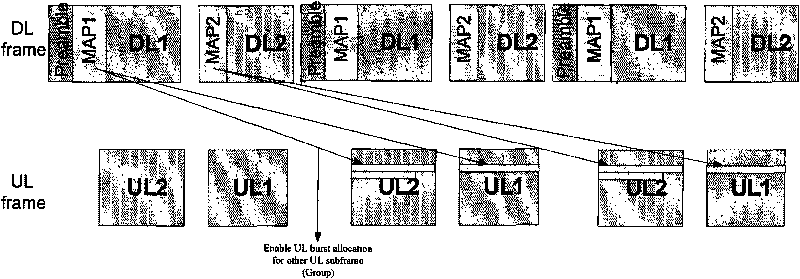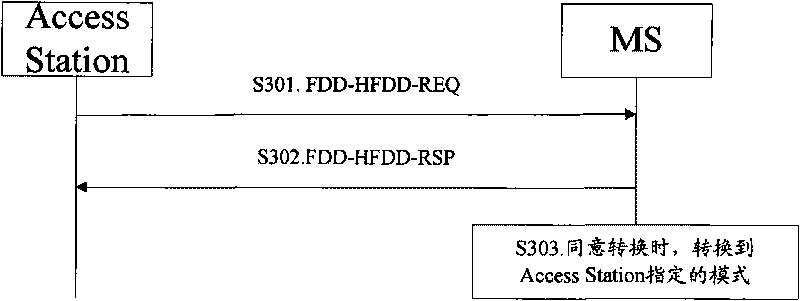Mode converting method, device and system in FDD (Frequency Division Duplexing) scene
A mode conversion, H-FDD technology, applied in the direction of electrical components, wireless communication, power management, etc., can solve the problem that MS cannot realize mode conversion, etc., and achieve the effect of facilitating flexible allocation, avoiding excessive power consumption, and facilitating resources
- Summary
- Abstract
- Description
- Claims
- Application Information
AI Technical Summary
Problems solved by technology
Method used
Image
Examples
Embodiment 1
[0056] This embodiment describes the mode conversion actively initiated by the Access Station in various situations.
[0057] 1. Mode conversion during normal communication
[0058] like image 3 As shown, the mode conversion initiated by the Access Station in this embodiment includes:
[0059] S301. The Access Station sends a mode switching request message to the MS.
[0060] During normal communication between the MS and the Access Station, the Access Station finds that the MS needs to perform a mode switch, from F-FDD mode to H-FDD mode or from H-FDD mode to F-FDD mode, and will send a mode switch message to the MS. The request message FDD-HFDD-REQ requires the MS to perform corresponding mode conversion. The request message FDD-HFDD-REQ includes relevant parameters for requesting MS to switch from F-FDD mode to H-FDD mode or from H-FDD mode to F-FDD mode.
[0061] There may be various reasons that cause the MS to perform mode conversion, for example, the amount of data...
Embodiment 2
[0096] This embodiment describes the mode switching initiated by the MS under various circumstances.
[0097] 1. Mode conversion during normal communication
[0098] During the normal communication between the MS and the Access Station, if the MS finds that it is necessary to perform mode conversion, it initiates a mode conversion request. Specific operations such as Figure 4 shown.
[0099] S401. The MS sends a mode switching request to the Access Station.
[0100] MS finds that the current amount of data interaction is small, and it is necessary to switch from F-FDD mode to H-FDD mode, and then it will send a FDD-HFDD-REQ request message to Access Station, requesting to switch to H-FDD model. The request message FDD-HFDD-REQ includes relevant parameters for requesting the MS to switch from the F-FDD mode to the H-FDD mode.
[0101] The present invention is not limited thereto, and it may be caused by other reasons that the MS needs to switch modes, for example, the loa...
Embodiment 3
[0134] In this embodiment, under IEEE 16e, the mode switching is initiated by the BS actively.
[0135] 1. Mode conversion during normal communication
[0136] This embodiment first describes the mode switching performed during normal communication between the MS and the BS.
[0137] like Figure 5 As shown, the mode conversion method in the FDD scenario of this embodiment in IEEE 16e includes:
[0138] S501. The BS (Base Station, base station) finds that the MS needs to switch to the H-FDD mode during communication in the F-FDD mode, and then sends a mode switching request message to the MS.
[0139] During the communication process, the BS finds that the amount of data exchanged through the MS is very small, so it is considered that the MS needs to switch from F-FDD to H-FDD, so as to reduce power consumption. BS sends FDD-HFDD-REQ to MS, requesting MS to do mode switching. The request message FDD-HFDD-REQ includes relevant parameters for requesting the MS to switch from t...
PUM
 Login to View More
Login to View More Abstract
Description
Claims
Application Information
 Login to View More
Login to View More - R&D
- Intellectual Property
- Life Sciences
- Materials
- Tech Scout
- Unparalleled Data Quality
- Higher Quality Content
- 60% Fewer Hallucinations
Browse by: Latest US Patents, China's latest patents, Technical Efficacy Thesaurus, Application Domain, Technology Topic, Popular Technical Reports.
© 2025 PatSnap. All rights reserved.Legal|Privacy policy|Modern Slavery Act Transparency Statement|Sitemap|About US| Contact US: help@patsnap.com



